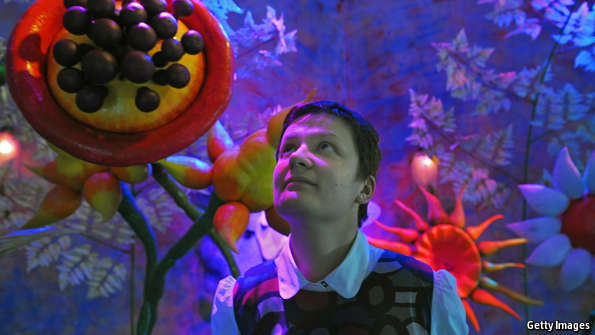THE small Polish town of Pacanow has survived wars, revolutions and floods. It is a nondescript place, but it has one advantage over cities renowned for their cathedrals and palaces. Its own claim to fame is indestructible: it is home to Koziolek Matolek, the goat at the middle of the country’s best-known children’s comic book.
“When I first went to visit Pacanow, it was very depressed, with 40% unemployment,” recalls Waldemar Dabrowski. “I thought, this is crazy, Pacanow is famous to every Pole.” At the time Mr Dabrowski, the head of the Polish National Opera in Warsaw, was the country’s culture minister. It was 2002 and Poland was pushing towards its long-desired entry into the European Union. “I told the city council, ‘We’re in a market economy now; what matters is name recognition. Have the goat work for your prosperity,’” says Mr Dabrowski. So the council did—and the town is now home to the country’s first fairy-tale museum (pictured). Inspired by the goat’s potential, Mr Dabrowski went to Brussels to put a proposal to the European Commission: the Polish government was going to invest heavily in cultural infrastructure and he wanted the EU to match the Polish funding. The result would be a network of new or rebuilt opera houses, museums, theatres and concert halls that would not only benefit Polish concert-goers, but also the EU. As Mr Dabrowski, who remains Poland’s de facto cultural impresario, put it to Viviane Reding, the culture commissioner at the time: “People with access to culture work better and have a better family life than those who don’t.” Poland, which had seen its relatively small number of concert halls and opera houses decay during decades of communist rule, would provide an excellent opportunity to test the hypothesis.
So the council did—and the town is now home to the country’s first fairy-tale museum (pictured). Inspired by the goat’s potential, Mr Dabrowski went to Brussels to put a proposal to the European Commission: the Polish government was going to invest heavily in cultural infrastructure and he wanted the EU to match the Polish funding. The result would be a network of new or rebuilt opera houses, museums, theatres and concert halls that would not only benefit Polish concert-goers, but also the EU. As Mr Dabrowski, who remains Poland’s de facto cultural impresario, put it to Viviane Reding, the culture commissioner at the time: “People with access to culture work better and have a better family life than those who don’t.” Poland, which had seen its relatively small number of concert halls and opera houses decay during decades of communist rule, would provide an excellent opportunity to test the hypothesis.
More than 700 projects duly received 4.7 billion zloty (around €1.2 billion) from the Polish government between 2007 and 2013, including 79 projects as part of the national programme (2.3 billion zloty) and some 650 projects as part of the regional programme (2.4 billion zloty). During the same period, the country got €67 billion from the EU’s structural fund, of which just over €1 billion was for the development of cultural infrastructure and the protection and preservation of heritage.
The investments have generated a remarkable audience boom. Between 2004 and 2013, the number of museum visitors rose from 17.5m to 29.0m, visitors to art galleries from 3.0m to 4.5m and audiences for theatres and concerts from 9.3m to 11.5m. Mr Dabrowski’s plan has borne considerable fruit on a smaller level too. Pacanow’s museum receives 500 visitors a day. Białystok, a city of around 300,000 souls near Poland’s eastern border, has a new opera house and concert hall. In Zakliczyn, a tiny town two hours from Krakow, young musicians attend classes with leading practitioners at the Krzysztof Penderecki European Centre for Music. Mr Penderecki, a famous composer of atonal works, teaches there too.
Despite its sizeable population—some two million in the metropolitan region—Katowice had previously lacked a concert hall. Now it has a new one for the Polish National Radio Symphony Orchestra, as well as an Academy of Music. The Krakow Opera also has a new building, as do the Szczecin Philharmonic, the Academy of Music in Poznan and the Polish Baltic Frédéric Chopin Philharmonic in Gdansk.
“We used to play in a really uncomfortable hall: poor place, poor sound,” says Ewa Strusinska, the music director and principal conductor of the Szczecin Philharmonic. “Our new building…has made an enormous difference both for the players and the audience.” Ms Strusinska points out that the orchestra’s season is now sold out, even though the new building has two halls and thus more seats to fill. “And we’re getting a new audience,” she adds. “It’s easy to tell because people are clapping between the movements.”
Mr Dabrowski is unapologetic about a cultural splurge that will not necessarily cater to all tastes. “A country needs culture in order to grow,” he argues. “Otherwise society is just about fulfilling biological needs. If you create artistic spaces, new talent will emerge.”




























